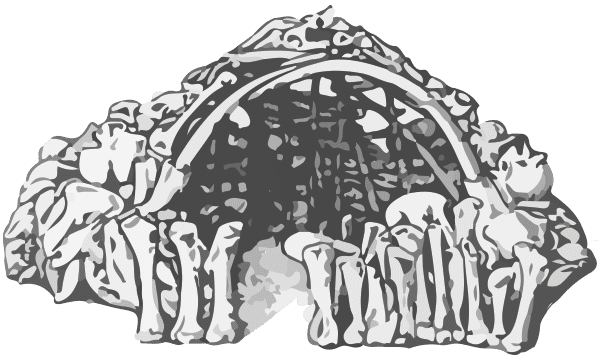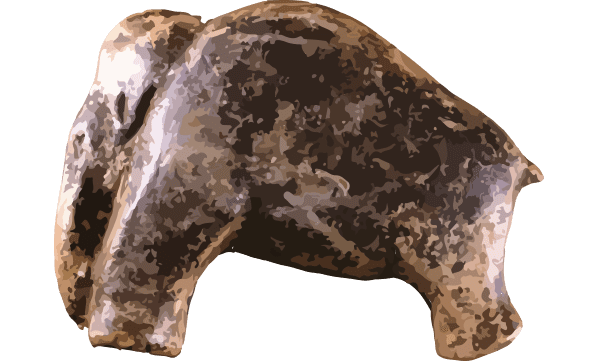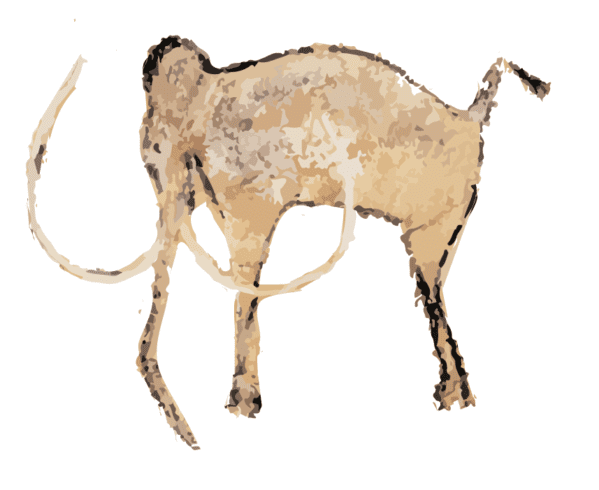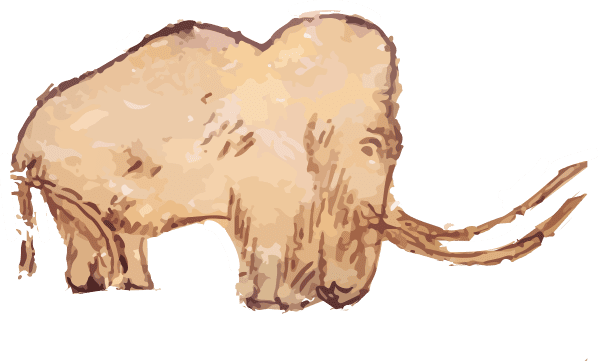The woolly mammoth (Mammuthus primigenius) was a shaggy, Ice Age giant and one of the last surviving members of the mammoth family. These incredible animals roamed the earth from the Middle Pleistocene until their extinction in the Holocene—meaning they walked alongside early humans for quite a long time! Woolly mammoths were part of a long mammoth lineage that started with Mammuthus subplanifrons in Africa during the early Pliocene. Around 800,000 years ago, the woolly mammoth branched off from its cousin, the steppe mammoth, most likely in cold, snowy Siberia. Believe it or not, their closest living relative today is the Asian elephant! In North America, woolly mammoths even shared territory with another species called the Columbian mammoth. Fascinatingly, DNA studies show the two sometimes interbred—sort of like distant cousins meeting up again. People in Asia knew about mammoth remains long before Europeans did, but for centuries, no one really knew what they were. Some thought the bones came from mythical beasts! It wasn’t until 1796 that French scientist Georges Cuvier officially recognized the woolly mammoth as an extinct relative of modern elephants.

If you had stepped outside about 20,000 years ago, you’d definitely want to bundle up—even in summer! Back then, the Earth was in the middle of an ice age, with huge glaciers stretching across much of North America, Europe, and Asia. It was a chilly world where early humans shared the landscape with some truly incredible animals—like the mighty, now-extinct mammoths, distant cousins of today’s elephants.
Ancient elephant
One particular species—the woolly mammoth—wandered across the chilly tundras of Europe, Asia, and North America starting around 300,000 years ago. They were built for the cold and thrived for ages. Amazingly, while most of them disappeared about 10,000 years ago, a small group managed to hang on until around 1650 B.C.—that’s more than a thousand years after the Pyramids of Giza were built!
Woolly mammoths were big, shaggy plant-eaters that spent much of their time grazing on shrubs, grasses, and other vegetation. They used their impressive 15-foot-long tusks to sweep away snow and dig for food buried underneath. Much like modern elephants, mammoth moms probably gave birth to one calf at a time, and they stuck together in tight-knit family herds—usually about 15 members. The young males would eventually strike out on their own around the age of 10.
Snow ready
Woolly mammoths were roughly the same size as today’s African elephants—standing tall at about 13 feet. But unlike their modern cousins, they had much smaller ears to help them hold on to body heat in freezing temperatures. Their thick double coat also did the trick: the shaggy outer layer could grow up to 20 inches long, acting like a built-in winter blanket to keep them warm—even when it was a bone-chilling minus 58°F! They also had a distinctive hump on their back, which scientists believe was a fat reserve, giving them extra energy during tough, food-scarce times—kind of like a camel’s hump.
Scientists aren’t sure exactly why woolly mammoths went extinct: Some think that humans hunted too many of them, and others believe that they couldn’t survive Earth’s naturally warming climate. Or, it could’ve been a combination of both.
Woolly mammoths Structure
The woolly mammoth (Mammuthus primigenius) was a truly remarkable species of elephant that once roamed across Europe, northern Asia, and North America during the chilly days of the Pleistocene and Holocene epochs—stretching back as far as 2.6 million years ago. These shaggy giants were famous for their impressive size, thick fur coats, and long, curved tusks. Woolly mammoths were perfectly built for the Ice Age, but as the Earth began to warm and their frozen habitats started disappearing, they couldn’t keep up and eventually went extinct. Fittingly, they get their name from the long, woolly fur that helped them brave the cold.

Woolly mammoths were truly impressive creatures, standing around 10 to 12 feet tall—that’s as tall as a small building—and weighing between 6 and 8 tons! To survive in freezing climates, they were built like walking blankets. They had a thick, yellowish-brown undercoat about an inch thick, hidden beneath long, shaggy dark brown hair that could grow over two feet in length in some individuals. Beneath their tough skin, they carried a cozy layer of fat—up to 3 inches thick—to help insulate them from the cold. Their skulls were large and dome-shaped, topped with long, curved tusks that pointed downward and could grow to massive lengths. These tusks weren’t just for show—they likely helped with digging through snow or defending against predators. Their teeth were specially adapted for constant chewing, made of alternating plates of enamel and dentine that wore down over time from all that grinding. Unlike modern elephants, mammoths had small ears, which helped reduce heat loss. And on their backs? A fat-filled hump that worked like a built-in energy and water reserve—sort of like a furry camel of the Ice Age
WOOLLY MAMMOTH REVIVAL
300,000 years of evolution
Mammoths have quite the family tree! Their lineage split from the Asian elephant around 6 million years ago. The earliest known member of this group was the Mammuthus meridionalis, or southern mammoth, which eventually evolved into the massive Mammuthus trogontherii, also known as the steppe mammoth—the biggest mammoth species ever to roam the Earth. Then, around 300,000 years ago, the famous woolly mammoth (Mammuthus primigenius) made its debut in eastern Siberia. These woolly giants later crossed the Bering land bridge into North America and thrived across the cold, grassy steppe landscapes during the Ice Age. Though a bit smaller than today’s African elephants, woolly mammoths were tough and well-adapted to the chill, surviving many harsh winters. But things started to change around 10,000 years ago when their numbers began to drop. Still, a small group of woolly mammoths held on—surviving on a remote island in the Arctic Ocean called Wrangel Island—until about 4,000 years ago. That means they were still around long after the pyramids in Egypt were built!

30,000 years of symbolism
Fascination with mammoths is not new. The mammoth is intimately tied to human history. Not only were mammoths hunted, they were also idolized. The oldest figurative art in Europe includes mammoth carvings on mammoth ivory. Cave paintings such as the 32,000-yeaold images at Chauvet Cave in Southern France are among the oldest known art in the world. Over 100 mammoth paintings dated to about 20,000 years old adorn the walls of Rouffignac cave. Mammoth bones were used to make tools as well as art and were even used in burials. At a 15,000-year-old village in the Ukraine, people constructed four huts out of mammoth bones.

Mammoth bone hut, Mezhyrich, Ukraine. 15,000 years old.

Carved mammoth figurine from Swabian Jura plateau, Germany. 35,000 years old.

Chauvet Cave mammoth art, south France. 30,000 years old.

Rouffignac Cave mammoth painting, France. 20,000 years old.
300 years of paleontology
When people first found mammoth bones, they actually thought they belonged to giants from the Bible! It wasn’t until 1728 that a doctor named Hans Sloane figured out these bones were actually from elephants. Then, in 1796, French anatomist Georges Cuvier was the first to suggest that these fossils didn’t belong to any living elephants but to a completely different species that had gone extinct. Back then, extinction was just an idea, not a proven fact. In fact, President Thomas Jefferson was so sure that living mammoths and mastodons still roamed the wild that he believed the 1803 Lewis and Clark expedition would find some in the unexplored lands west of the Louisiana Purchase. But as the maps got filled in and no mammoths showed up, scientists realized extinction was real.
One of the most iconic animals that made their home on the Bering Land Bridge was the woolly mammoth.
Woolly mammoths were roughly the same size as today’s African elephants — pretty huge! Back in the Ice Age, lots of herds of these gentle giants roamed the land bridge, always on the lookout for tasty food to fill their big appetites. You can actually tell what they liked to eat by looking at their teeth. Mammoths had flat molars, perfect for munching on grasses. Their cousins, the mastodons, had molars with bumpy, rounded ridges, which helped them nibble on woody plants like trees and shrubs. So even though they were related, they had different favorite snacks!
Dig Deeper into the History of the Woolly Mammoth
When you think of the Ice Age, it’s hard not to picture the woolly mammoth — this huge, furry giant really was the star of that time. In fact, it was so famous that scientists named a whole ecosystem after it: the “mammoth steppe.” That’s just a fancy way of saying the vast, grassy plains that stretched across much of northern North America, Asia, and Europe during the Ice Age. These productive grasslands were home to the woolly mammoth and lots of other amazing animals.
Though woolly mammoth remains account for only about five percent of the fossil record from ice-age Alaska, it is known that the creature constituted over a third of the ecosystem’s biomass with respect to mammals (Matheus, pp. 55). This was partly due to its sheer size and to the fact that it was one of the most common animals to be found on the ice-age steppe of Alaska.
Modern Relatives
The woolly mammoth, whose fancy scientific name is Mammuthus primigenius, is actually a close relative of today’s African and Asian elephants. All three of them belong to the same elephant family and are thought to have come from a common ancestor way back in Africa—a creature with the cool name Primelephas gomphotheroides. So, you could say the woolly mammoth was like a distant cousin of the elephants we know today!
Recently however a joint scientific venture involving scientists from Hokkaido University in Japan and the Russian Academy of Sciences in Moscow, analyzed Ribosomal RNA gene sequences in all three species. Results of the study showed that the woolly mammoth is actually more closely related to the African elephant than to the Asian elephant (Noro, pp. 314).
Diet, Appearance, and Behavior
The ice-age woolly mammoth, in contrast to its present day African and Asian cousins, was strictly an herbivorous grazer as it could no doubt be found consuming bunches upon bunches of grass and vegetation (Matheus, pp. 55). With tusks weighing next to 200 pounds, each of which measuring well over twelve feet in length (Matheus, pp. 55), the woolly mammoth was as important a species in ice-age Alaska as any.
Looking very much like a short elephant with a shaggy coat of insulating hair, the woolly mammoth had droopy hindquarters that eventually culminated to a domed shaped skull topped with a tuft of hair (Matheus, pp. 57). While its back end had a tiny hairy tail, – there would be no reason to have a long tail in such a cold climate as ice-age Alaska – its front end sported a bifurcated trunk that was split at the tip. Like the thumb and fingers of your hand, the trunk would easily grab the clumps of vegetation that could be found underfoot. Some postulate that the mammoth may have also used this very same technique to put snow in its mouth for water (Matheus, pp. 57).
Both sexes carried a pair of ivory tusks which among other things, were used to display status and fitness. As has been observed amongst the behaviors of modern elephants, woolly mammoths are also believed to have engaged in heated physical battles often leading to fatal injuries. Evidence for this may in fact be shown in the fossil record seeing as how many fossilized mammoth tusks have been found broken, shattered, or worn (Matheus, pp. 57) though this is by no means any direct proof of such behavior.
Archaeological Findings
Much of the attention and notoriety that the woolly mammoth has garnered in recent years has come from archaeological findings of mammoth remains, particularly mummified remains. Many cases of mummified mammoth remains have taken place in Alaska and Russia. Mammoth mummies form when a specimen becomes buried by sediments relatively quickly following its death. At the same time, a rise in the permafrost table has to take place, at which point the carcass would freeze while suspended in a more or less preserved state on account of the sediments (Matheus, pp. 58).
What results in turn, is the mummification. Over the course of millennia, the dry frozen soil sucks moisture out of the carcass, a process that University of Alaska at Fairbanks paleontology student Paul E. Matheus says is analogous to freezer burned meat. “Just imagine what an unwrapped moose steak would look like after being left in a freezer for 30,000 years (Matheus, pp. 58).” What you get ultimately, is a naturally mummified mammoth that is almost completely intact, save for the fact that it would be gnarled and deflated from eons of time under the frozen Earth.
Many of the things which we now know about wooly mammoths would be nonexistent if this natural mummification process were not to have taken place. That is how the mammoth’s hand-like trunk and toupee-like tuft at the top of its head were discovered. Mummies from about ten other species of Pleistocene mammals have been discovered in Alaska including steppe bison, caribou, muskoxen, moose, voles, horses, lynx, hares, pikas, and ground squirrels.

